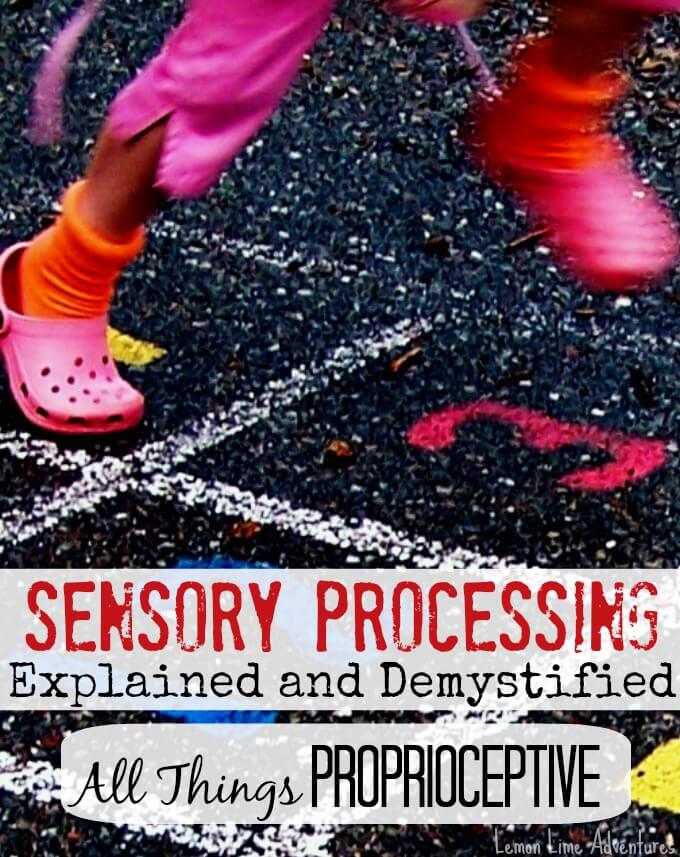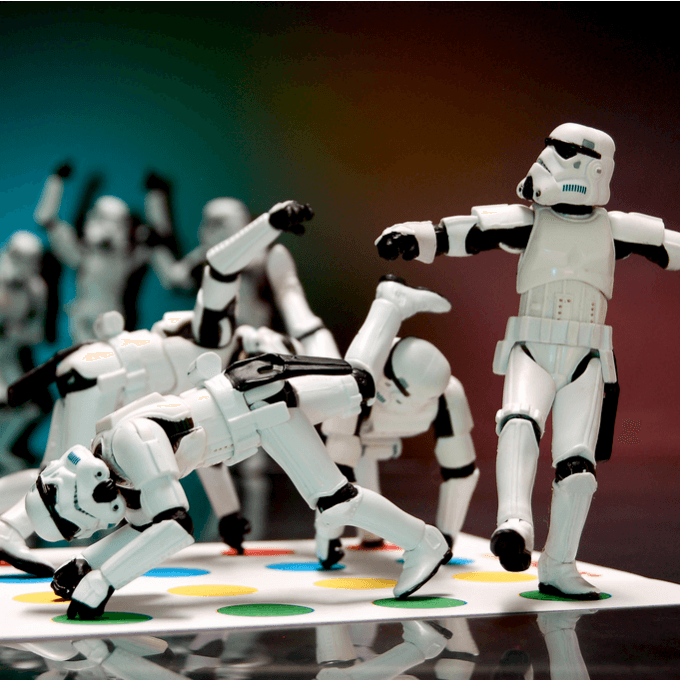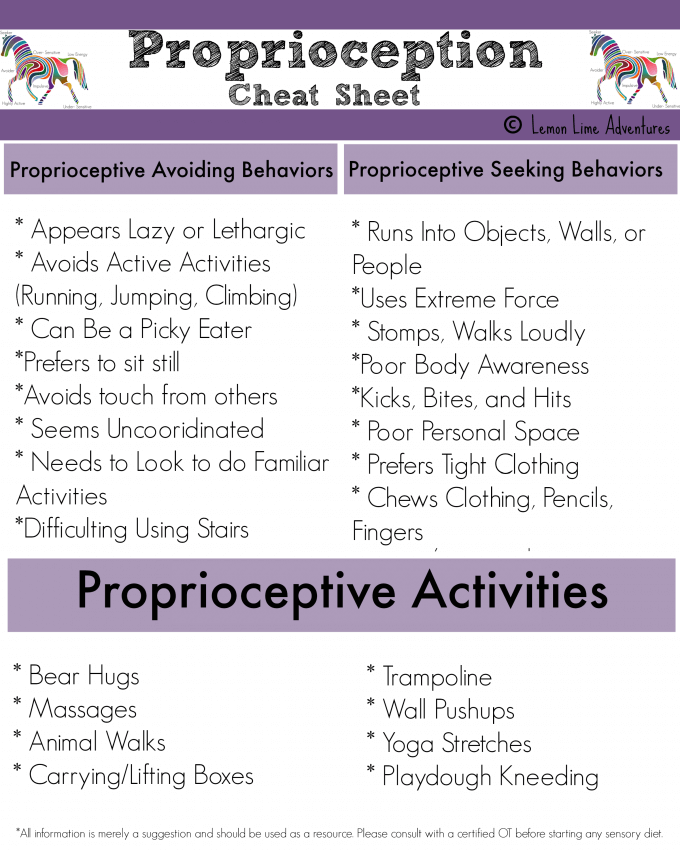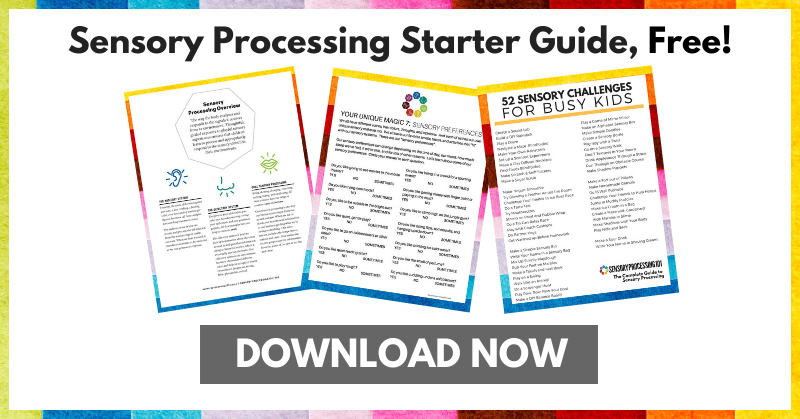Who knew there were more than 5 senses? I know I didn’t, until recently. Unfortunately, many of us are only taught the most common 5 because the other two are supposed to be so automated that we shouldn’t have to think about them. That is why I am excited to join with my friends at The Inspired Treehouse, a group of pediatric physical and occupational therapists, to bring you this series on all things Sensory Processing. This month we are talking about Proprioceptive Input and its importance for growth and development in kids.
{THIS POST MAY CONTAIN AFFILIATE LINKS TO MATERIALS I RECOMMEND. ANYTHING YOU PURCHASE THROUGH THESE LINKS HELPS SUPPORT LEMON LIME ADVENTURES. THANK YOU IN ADVANCE FOR CHOOSING TO SUPPORT US.}
Just like last month, I will attempt to explain an aspect of Sensory Processing from my perspective. I will not attempt to use medical terms, explain what I don’t understand myself, or pretend to be an expert. My good friends, at The Inspired Treehouse, will bring you their take on the same topic, giving you a better understanding of Sensory Processing.
REMEMBER:
I am not a therapist or a doctor.
I am, simply, a mom raising a child with sensory needs.
I am, simply, an educator who taught in Early Childhood Education for 12 years.
I am, simply, just like you.
Proprioceptive. Proprioception…. Both of these words just tie my tongue trying to say them. I’ve been dreading and excited about this edition in our series on Sensory Processing since the beginning. From the day I learned about proprioceptive input and to this day, I still slow down just to make sure I am saying it right. Then, I send a quick glance over to someone that knows what they are talking about, just to make sure I got it right.
If I had to define the Proprioceptive System without using medical terms, I would define it as our body’s ability to sense where we are in relationship to our surroundings.
Think twister, simon says, or even hop-scotch. All of these classic games require us to use our body’s sense of awareness to interpret the world around us. Pushing, pulling, stomping, squeezing, jumping, bending. All of these things have one thing in common…
Body Position
photo credit: Kalexanderson via photopin cc
Without our proprioceptive system, we are unable to know where different parts of our body are without looking. I bet right now, you could close your eyes and still touch your finger to the tip of your nose, right? Yep. That is because of your proprioceptive system. This system is responsible for helping us move through space and move our body effectively.
Anytime you climb stairs, run down the street, carry a load of laundry, sit, stand, bend or stretch, you are using your proprioceptive system. If I have learned on thing about proprioception, it is that our body receives information for this sense through our muscles and joints effecting our self awareness, emotional security and our ability to feel safe and secure in our surroundings.
If you are like me, you are wondering what this all means. What does this look like and why is it important?
As I mentioned before, Proprioception is all about body position. All children require this awareness and input for proper development. The problem occurs when a child is either over or under responsive to receiving information from this system.
As an educator, I vividly remember my first encounter with a little boy who would reach his hands out as far as he could beside him, run through the classroom, and hit everything and everyone in his path. He looked like an airplane with his wings stretched wide, coming in for a crash landing. Then there was the little girl who would bite and hit anyone she sat next to in circle time no matter what tactics and methods we tried. Little did I know at the time, these little bitties were screaming for help. They were telling me that they needed proprioceptive input!
On the flip side, I had those students. THOSE STUDENTS. The ones that NEVER wanted to do anything with the group. They NEVER wanted to be touched. They disliked almost any activity. In fact, when we would go to the playground… they would LAY DOWN. Who does that? What kid wants to lay down at the playground.
You know what word people would use to describe those kids… yeah, its ugly, but its used all the time… LAZY.
Sadly, no one knew (including me) those kids’ brains were telling them to avoid input that would be too much work for their muscles and joints. Their brain was trying to protect them and no one knew.
In my home, as a mom, this looks a lot like the first story of my classroom except it just wasn’t so obvious. I thought my son was “Bad”, “naughty”, and any other word that might fall in that category. I used to wonder “What am I doing wrong?”
You know how little boys LOVE to wrestle and rough house? Well, in my house this can’t happen. The minute we begin to tickle, wrestle, or goof around… someone gets hurt. Seriously HURT! Legoman has no gauge. He can not stop at a reasonable level and resist the urge to push, pull, hit or grab. He takes it too far.
Then there’s the chewing. OH! The chewing. While I know most of us associate chewing as an “oral” behavior, I have learned how closely related this is to the proprioceptive system. Legoman has successfully chewed his entire bedpost to shreds, broken all the pencils in the house (With his teeth), and even chewed off his brother’s nails.
I could write on and on about this system. While I know they are all interconnected… this is the area we see the most outward appearances in our home. I will leave you with this… until Legoman was 7 years old, he NEVER hugged me. NEVER! He would push on me, bury his head on me, but NEVER hug me. It was not until we began occupational therapy, chiropractic care, trampoline games and other things that he began to actually want to be hugged and cuddled.
Remember, Sensory Processing is Complex. It is different for every child, because every child is unique. The problems arise when a child either seeks or avoids proprioceptive input. For your convenience, I have compiled a Proprioception cheat sheet listing behaviors you might see if your child is with avoiding or seeking this type of input.
Now its time to hop over to my good friends at The Inspired Treehouse, where they are sharing their tips as Pediatric therapists to explain Proprioception and why they it is important to the growth and development of all children.
I love this video from Brain Highways on Proprioception. It provides such a clear visual for what is happening to he body when this system is not regulated or is out of sync.
Some of my Favorite Proprioceptive Activities
I love the list of heavy work activities compiled on Sensory Processing Disorder.com.
Creative with Kids has a handy printable of Sensory Activities with Kids which includes several proprioceptive activities.
A go to list for us, is this list of Heavy Work Activities for the home from Sensory Street.
Follow Dayna :: Lemon Lime Adventures’s board Sensory Processing Resources on Pinterest.
Follow Dayna :: Lemon Lime Adventures’s board Sensory Play on Pinterest.
If you are looking for more ideas for Sensory Processing, you can check out my favorite picks on Amazon.
Do you know a child that seeks or avoids proprioceptive input? Do you have a child with sensory needs? Has this post touched you in some way? I would love to know! Please send me a message or leave a comment. It helps when we know we are not alone. Click the picture below to join our Support Group for Sensory Needs.
More from the Sensory Processing Resources
Sensory Processing | Tactile | Vestibular | Proprioceptive | Auditory | Visual
Kids that struggle with regulating their proprioceptive system are often mislabeled as pushy, angry, or mean. What if we could change the way the world saw these kids, and better yet… change the way they saw themselves?














I stole the small trampoline from my parents basement a week ago and set it up in my living room.. it’s annoying and in the way but Boo will jump on it as he runs through the house, will go sit and bounce on it while he builds his Legos, will just jump away and it has REALLY helped him not be so wiggly at night.. I love the thing! Even when I hit it with my toe in the middle of the night.. well ok maybe not THEN 😉
That was the best video I’ve seen to describe what it is and how kids react. Thank you!
100% agree!
Wow-we have similar stories. I also have an Early Childhood Degree and I taught preschool for 6 years. Never knew about any of this until oldest, who is almost 9, was diagnosed at 4 1/2! You explain it so well! OT makes a WORLD of difference! 🙂 Keep on keeping on! You’re doing a great job momma!
Loved this article! I shared it with a facebook autism support group I’m a part of. So great to get more ideas on how to help our kids. I have felt for a long time that my son needed something from me when he got into what I called his manic stages of crashing around and his body seemed to be out of control. Thanks to OT and finding articles like this, I feel more able to give him what he’s asking for and help him calm his body. Thank you so much!
Dayna, this is a fantastic article. I’m a paediatrician and have never come across children with proprioception problems before. You describe proprioception really well and the problems that these children face. Thank you for such an interesting read.
Thank you so much for your kind words. It means a ton hearing that from you!
Wow, iv followed your posts for a little while as my youngest daughter always seemed to be totally absorbed by all the sensory play I offered her after seeing your ideas. I love scientific and medical articles and read this article… Wow its just described my daughter to the letter. No idea where to go or what to do armed with this knowledge but know I can say to those who say she’s a loud, naughty clumsy walking disaster that there IS a reason why she’s falls over thin air 20 times a day, sounds like an elephant having a party when she tries to tiptoe, whacks you in the face when trying to talk to you then stands up and headbutts your jaw before walking off chewing her own hand.
Wow, your comment just brought me to tears. I remember the days of feeling so lost with my son’s behaviors. Honestly some days I still feel lost but it does help to know there may be a reason he is doing the things he is doing. I hope you will come join our support group.
I’d really love to, I’d like to find out more so I can understand my little superhero and help her rather than hinder her plus knowledge may help me make things safer for her and my other daughter. How do I join? thank you so much for your kind words and thank you with everything I have for the amazing article… Without it I may never of known x
Thanks for posting all this. Best information easy to understand what is going on with my 2 years old. And the most important, how to help her. Thanks a lot. I will start using the strategies and I will keep you posted. Sharing with my whole family so we understand and help my little girl, thanks
I see much of these symptoms in my 4.5yrs old son..was thinking of something wrong with him.. Still not sure…. Pl guide me where to go and whom to talk..
I have a sensory kid, too ~ depending on the day and situation, she either avoids or seeks proprioreceptive input. Loved reading this post and the descriptions ~ she is one that will lay down on the playground if she is feeling overwhelmed 🙂 I was so glad when we figured out the reason behind her sometimes odd behaviors! For her, we’ve also found skin brushing to be immensely helpful! Not sure if you’ve tried it with your son (I’m a first-time reader) but if not, look it up ~ our daughter has really benefited greatly (and will ask for “brushes and squishes” when she is feeling out of sorts now)
So…. why is this only a children’s need? Don’t all of us need to move and touch and jump?
I am an adult and if don’t get to lift things or jump around first thing in the morning I don’t have the patience to sit at a desk either. Moving is normal. Being quiet isn’t.
It actually isn’t just a child’s need. It is a need that all humans have. The problem arises when children are unable to process the sense appropriately.
Pingback: Sensory Benefits of Sand Play - Melissa & Doug Blog
Pingback: Free Chore Chart | Heavy Work to Focus and Calm Kids - Lemon Lime Adventures
Pingback: 5 Sensory Activities that Help with Focus
Pingback: Sensory Processing Play: Laundry Basket Push Game - Golden Reflections Blog
Pingback: Sensory Tools | Sensory Kit for School or Home - Lemon Lime Adventures
Pingback: Sensory Processing Explained | Oral Sensory System - Lemon Lime Adventures
I found this blog completely by accident when someone posted the glitter slime link on facebook and as my son has been diagnosed as mildly autistic and seems to function better when he has things in his hands I went to see how to make it. Then I found this HOLY MOLY ALL OF THE THING ANSWERED! I printed a copy of the proprioception cheat sheet out for my son’s pre-school and the teachers have had so much success with activities for him and some of the other kids! He seems to be a proprioceptive seeker and weighted blankets for bed means no more fighting to get him to sleep after about 5 minutes he’s out like a light!
THANKYOU <3
I am so happy you found your way here! I am even happier that this was helpful! That makes my heart smile!
My six year old grandson was diagnosed with SPD last year and I have so much to learn. Thanks for these articles and your insight.
I am glad you found these helpful. Keep us updated on your journey with your grandson.
Wow, this makes so much sense to me. I think you just shifted my view of my child….mind blown. 🙂
Pingback: Tactile Input: Sensory Processing Explained - Lemon Lime Adventures
Pingback: Sensory Processing: 7 Facts Everyone Should Know
Pingback: What is sensory processing and how can I understand my child? -
Pingback: 15 Super Simple Brain Break Exercises - Lemon Lime Adventures
Pingback: H is for Heavy Work Ideas for Kids - Golden Reflections Blog
Pingback: Supporting Your Child's Need to Move - Melissa & Doug Blog
Pingback: The Vestibular System | Never Less Than Everything
Pingback: Auditory System: Sensory Processing Explained - Lemon Lime Adventures
Pingback: Sensory Bottles: Learning Time Can be Playtime | Boone County CASA
Pingback: Article: “Proprioceptive Input: Sensory Processing Explained” By Lemon Lime Adventures
Pingback: This Week In Home School – Week 3 » See You In The Garden
Pingback: Vestibular Input: Sensory Processing Explained - Lemon Lime Adventures
Pingback: Awesome Sensory Bowling Activity for Kids - Lemon Lime Adventures
Pingback: 5 Developmental Benefits of a Dog for Kids
Hi! I am finding your blog a little late but I am so glad I did! My 3.5 year old son has just recently been diagnosed with SPD. After being kicked out of a home-based preschool for being “too aggressive” and needy, I want to learn more about Sensory issues to help him at home in order to teach the new preschool teacher about coping skills etc. We are fighting with insurance to cover OT.
Thanks for your help!
That is so difficult. Is there anything I can do to help. Anything I can help you find?
Thank you so much. I stumbled across lemin lime adventures a few months ago when the school agreed with me and stated they felt my son was dealing with something extra. Every penny dropped into place, all the pieces fit and even the angels sang!! This so describes my wonderful little boy. Thank you for sharing all your experiences xx
You are very welcome. I am so happy to hear this was where you needed when you needed help!
Thank you for this incredible insight. Answered prayer for me and the 12 preschoolers I spend my days with!
Pingback: Beginner's Guide to Essential Oils for Sensory Needs - Lemon Lime Adventures
Pingback: 45 Things Parents Love and Admire About SPD - Lemon Lime Adventures
Pingback: Sensory Benefits of Water and Pool Play - Melissa & Doug Blog
Pingback: Why Some Highly Sensitive Children Don't Like The Pool - Spoil My Family
Pingback: Dealing with Late Talking and Sensory Processing – HOMESCHOOL CRAFTS
Pingback: Sensory Processing: 7 Facts Everyone Should Know – Our Blog
Pingback: One Visual Editor Box for All Elements Test – Our Blog
Pingback: Sensory Benefits of Sand Play – Our Blog
Pingback: Don't Call My Kid a Cry-Baby! - Stir The Wonder
Pingback: How to Find the Perfect Gift for Kids Who Can't Sit Still
Pingback: All About Proprioception and Kinesthetic Awareness - kinesthetic-kid.com
Pingback: Sensory Hacks to Focus a Fidgety Child (That don't involve a Fidget Spinner)
Pingback: The Newbie's Guide to Sensory Processing | A Basic Overview
Pingback: The Other Senses: Proprioception • Sensory Processing Disorder
Pingback: Sensory Processing: What is Proprioception?